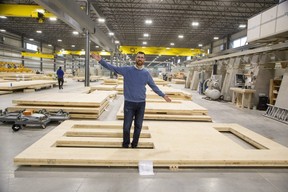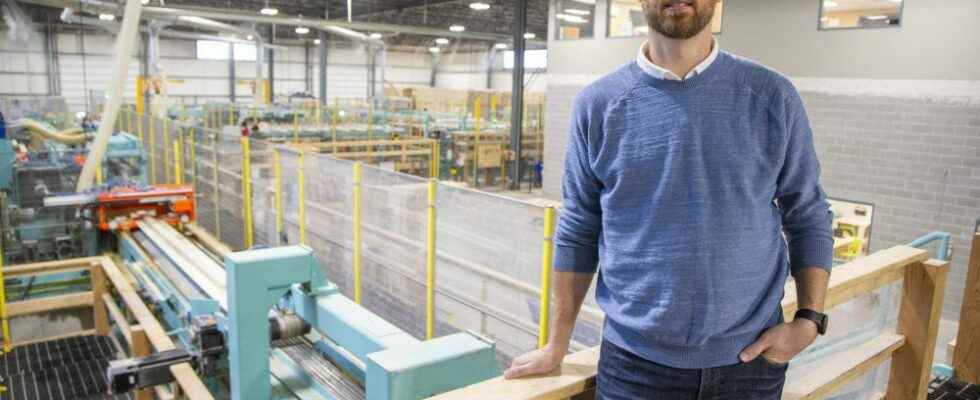A St. Thomas manufacturer is at the forefront of what may become a revolution in the building sector.

A St. Thomas manufacturer is at the forefront of what may become a revolution in the building sector.
Element5 manufactures wood beams and panels used in building construction. The company designs and cuts panels that become walls and ceilings. They are flat-packed, and shipped to a construction site where they are assembled to make a building, all from wood.
But the most revolutionary part may be the idea that making a building using engineered, laminated mass timber is more environmentally friendly than traditional techniques.
“This is good for the planet, and we need to radically change how we build buildings. Mass timber is a way we can do that,” said Sarah Hicks, manager of marketing and communications at Element5. “Wood is sustainable, renewable, and steel and concrete are not.”
Carol Phillips, an architect with Toronto firm Moriyama & Teshima Architects, knows Element5 well, having designed three mass timber buildings. She is designing two more.
“It’s remarkable, it’s influencing my practice and how I work,” she said. “It’s rooted in low carbon and renewable energy. We’re the gatekeepers to reduce carbon emissions in the industry.”
The construction industry contributes about 40 per cent of all global CO2 emissions and steel and concrete, about five per cent each of that total. Mass timber can reduce that total, Phillips said.
“The amount of carbon involved in mass timber is so greatly reduced from traditional materials like steel and concrete,” she said, and it’s also beautiful.

Element5 structures are in demand, Hicks said. The company began production less than a year ago, in April 2021, and already has sold 50 projects with forecasts to double orders this year, said Lee Scott, sales and business development manager at Element5.
The company has added a second shift and recently bought a parcel of land adjacent to its factory on Dennis Road, for future growth. “Mass timber construction is in a period of rapid expansion,” Scott said.
Element5 has built wooden structures across Ontario and is looking to expand into the US market. It employs more than 70 workers, having hired about five in the last month.
“Our potential for growth is enormous. The forecast is very strong,” Hicks said.
Element5’s building technique is “cost competitive” with steel and concrete and much faster to build, she said. When it landed a deal to build the new YWCA in Kitchener, the material was on site in six months and the building was up in 20 days, Hicks said.
It also has built a new Indigenous family center on Hill Street in London, called Nshwaasnangong Child Care and Family Centre, operated by the Southwest Ontario Aboriginal Health Access Centre.
“The technology available to create pre-fab panels has evolved and we have adopted that technology. Pre-manufacturing solutions are faster, safe and the results are precise,” Hicks said.
Element5 uses mostly two-by-six sections of spruce, pine and fir. It laminates together sections as large as 16 meters long, 3.5 meters wide and 40 centimeters thick, she said.
“We make panels and cut out everything. We design all the openings for connections required for electrical or plumbing down to the last screw hole. The panels are cut out to be a perfect fit, flat packed and shipped,” Hicks said.
Mass timber is not to be confused with the wood frame construction one would see for homes in subdivisions being built. That is called “light wood frame” construction.
Some Element5 builds:
- Nshwaasnangong child-care and family centre, Hill Street, London
- East Gwillimbury affordable housing
- Indigenous student center at Wilfrid Laurier University, Waterloo
- YWCA housing, Waterloo
- Toronto and Region Conservation Authority office, Toronto
- Port Stanley fire hall
- Oakville fire station
- Orillia waterfront center
- WOODin, 30,000 square foot office building, Waterloo
Element5 makes two products, large wood panels laminated together from which walls and ceilings can be assembled, as well as wood laminated together to make beams.
“They’re winning bids against other builders. They’re doing amazing things,” said Sean Dyke, economic development chief executive in St. Thomas. “They’re building across Ontario. They’re doing well.”
As for the safety and durability of wood as a building material, mass timber undergoes rigorous testing and certification, complying with building standards, Hicks said.
“We conform to building and safety codes the same as other materials. It’s safe, and the construction is precise,” she said.
One construction industry website naturallywood.com cited a fire resistance study of mass timber and found it exceeded building code standard even without fire resistant cladding on the wood surface.
In 2015, the national building code allowed wood structures to be built to a height of six storeys. In BC wood construction of 12 stores is allowed and there is support to have the national building code changed to reflect this. In some US states and in Europe mass timbers buildings are 18 stores.
As for the smaller environmental footprint for a wood structure, while concrete and steel create carbon in their manufacturing processes, mass timber captures and stores carbon as forests grow.
A 2019 study by the Yale School of the Environment found that a hybrid mass timber building achieved 26.5 per cent lower global warming potential than a concrete building. That same study also cited environmentalists saying mass timber needs more study before it can be declared sustainable.
But for Phillips, mass timber has many positive qualities, as on-site construction is fast, it can be assembled during cold weather, construction sites are quiet and the material is strong but lightweight.
“I’m a fan. I’m a supporter. It has so much potential,” she said.
Element5 has been mentioned in a documentary called Capturing Carbon about the climate crisis and the role forests play in managing the crisis.
Element5 has a 137,000-square-foot factory on an eight-hectare parcel of land and recently added a similar-sized portion of land a few months ago. It sources its wood from northern Ontario.
What They Said:
“The mass timber industry is plagued with misconceptions about building with wood, that it burns, does not last and is not structurally sound. There is sufficient research, testing and certification that proves those are misconceptions.”
– Patrick Chouinard, vice-president of business development for Element5
“This is a new, innovative sector. Mass timber can be a huge part of the global solution to the climate emergency we are facing.”
– Paul Robitaille, senior director, Indigenous and youth relations at the Sustainable Forestry Initiative
